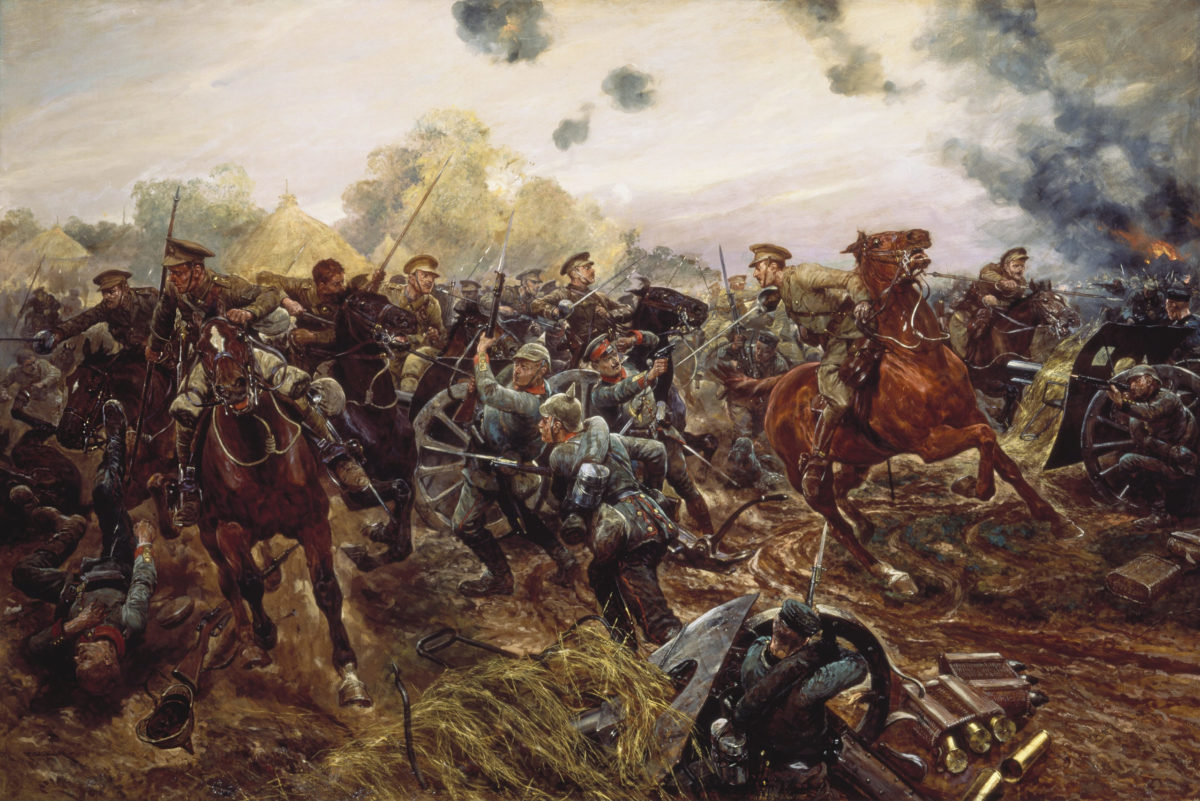On June 24, 1854, eight months into the Crimean War, Vice Adm. Sir Charles Napier, commander of Britain’s Baltic Fleet, sent three ships including the wooden paddleboat HMS Hecla to reconnoiter the channels and straits around the Russian fortress at Bomarsund in the Gulf of Bothnia.
As the three vessels worked their way through the Aland Islands toward the fort, they came under fire from ground forces and then from the fort itself. Shots came closer and closer to the ships until one well-aimed shell, its fuze still burning, landed on the eight-gun Hecla’s quarterdeck.
The heroic action by Hecla’s Midshipman and Acting Mate, Charles Davis Lucas, that happened next prompted the creation in 1856 of one of the world’s most famous and coveted valor medals—Great Britain and the Commonwealth’s revered Victoria Cross.
No Awards For Ordinary Soldiers
Two days after Lucas’ bravery saved his ship and presumably many of his shipmates, he was promoted to full lieutenant, but notably was not then given any military decoration or other award. The reason was that there was no suitable award available at that time for recognizing conspicuous bravery displayed by the British fighting man—especially those of lower rank. The only available military recognitions for their gallant deeds were a promotion or a Mention in Dispatches.
Yet, because of new 19th century technology, such as the telegraph and concurrent burgeoning proliferation of numbers and circulation copies of newspapers, news of the war and Lucas’ actions reached more public readership than ever before. Capturing widespread public attention, news of Lucas’ exploits—and soon of other Crimean War British heroes—unleashed a clamor demanding more honor be given to the average fighting man.
Medals and Knighthoods—For a Few People
Medals, military and otherwise, were not a new thing. A half-century before the Crimean War and long before Lucas’ act of courage, Napoleon himself noted that “a soldier will fight long and hard for a bit of colored ribbon.”
Ancient Egypt honored prowess at arms not with “bits of colored ribbon” but with membership in military orders, while Roman legionaries were honored with various crowns such as a naval crown awarded to the first man to board an enemy ship during battle. For centuries there were chivalric awards of knighthood and membership in various aristocratic military orders with their attendant sashes, stars, and badges. Britain’s Most Noble Order of the Garter was established in 1348 by Edward III, and King George I created the Most Honourable Order of the Bath in 1725; both are knighthood orders.
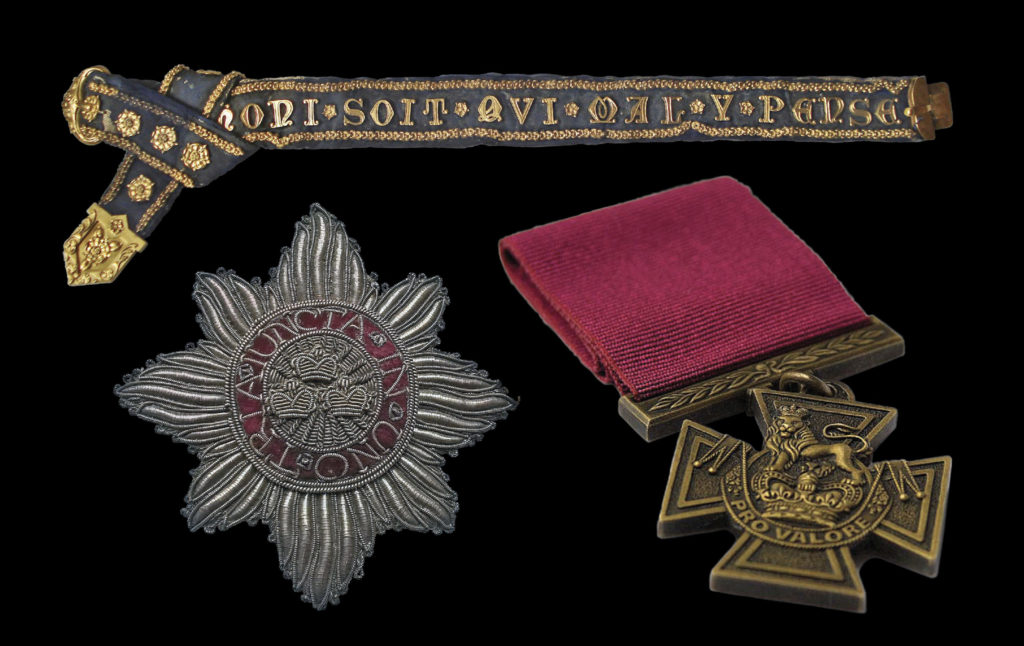
The first award that could truly be called “a medal” was the medal that John VIII Palaeologuscreated in Italy in 1438 and presented to court officials in Milan, Ferrara, Naples, Mantua, and Rimini. France also produced medals in the 15th century, and the Netherlands awarded a medal in 1519. In Britain, Queen Elizabeth I issued a commemorative medal in 1588 to mark the defeat of the Spanish Armada that year. Commemorative medals were also awarded to veterans of Napoleon’s 1798 Battle of the Nile. Prussia’s Frederick William III created a precursor of the Allgemeines Ehrenzeichen in 1793 for peacetime merit.
Gen. George Washington, commander-in-chief of the Continental Army during the American Revolution, created the Badge for Military Merit in 1782. Awarded to three men, it was forgotten until 1932 when U.S. Army Chief of Staff Gen. Douglas MacArthur created its rededication as the Purple Heart medal. America’s Medal of Honor, its highest valor decoration, was established by the War Department in July 1862 (December 1861 by the Navy Department) during the American Civil War.
France’s Napoleon III established the green and yellow Medaille Militaire award in 1852, one of the first awards made available to noncommissioned officers. The French even presented these medals to British soldiers during the Crimean War. However, Britain lagged in the creation of an individual medal for valor.
Enter the Crimean War
The Crimean War changed that. The war started in October 1853 between Russia and Turkey (the Ottoman Empire then). By March 1854, Britain and France had been swept into the conflict on Turkey’s side. That summer, the British Admiralty sent Napier and his Baltic Fleet into the Baltic Sea.
In June, Lucas’ act of heroism was prompted by Napier’s dispatch of the warships Hecla, Odin, and Valorous under Capt. William H. Hall to reconnoiter the scattered islands and approaches to the 80-gun Russian fortress at Bomarsund. As the three vessels worked a narrow channel near the 1832 fortress and came under fire, Hall, in an action some in the Admiralty later called “foolish,” returned fire and eventually attacked the fortress itself.
Lucas was then in charge of the paddleboat’s eight guns. When evening arrived, the three ships, joined by the 46-gun HMS Arrogant, dropped anchor within range of the fortress and launched a bombardment that lasted into the early hours of the following morning.
Lucas Saves the Day
During the height of this bombardment, a live shell landed on the Hecla’s upper deck—it’s timed fuze still burning its way to ignite the shell’s inner explosive charge. Officers scrambled and shouted for their men to hit the deck.
Ignoring the shouts, Lucas grabbed the hissing, sputtering shell with both hands, carried it to the rail, and threw it overboard. Before the shell reached the water, it exploded “with a tremendous roar.” That action, Capt. Hall of the Hecla later reported, saved “dozens of lives if not the whole ship’s company.” Lucas’ heroics had saved the Hecla’s crew, although the ship suffered minor damage and two crewmen were wounded.
Historian Glanfield explains in his book about the Victoria Cross, Bravest of the Brave, that at the time “explosive shells were essentially hollowed cannon balls powder-filled and primitively fuzed” with fuzes “cut to length by its gunners according to range to ensure it exploded close on impact.” Lucas was himself a gunner, Glanfield wrote, and thus knew the risks. He “was gambling on a miscalculation.” It was a gamble he fortunately won. British and French forces would finally take the Bomarsund fortress and demolish it in August.
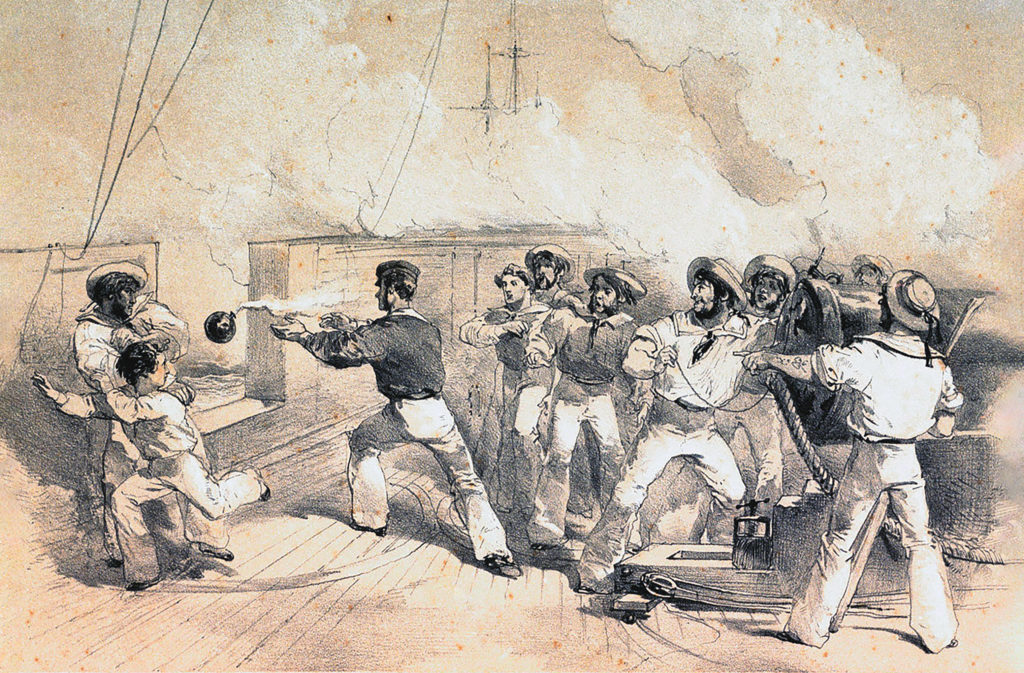
Lucas, then age 20, was already a navy veteran. He was born in 1834 in Poyntzpass, County Armagh, in today’s Northern Ireland and at age 13 joined the Royal Navy. He was praised by Hall for “a remarkable instance of coolness and presence of mind in action,” in Hall’s letter to Napier.
Clamor for ordinary heroes
By 1854, newspapers had proliferated. Samuel F. B. Morse had sent the first telegraph message a decade earlier, on May 24, 1842. Consequently, the Crimean War was the first major conflict covered by war correspondents who brought the British public into almost daily contact with the war via telegraph. Correspondents such as William Howard Russell of The Times included coverage of common soldiers and sailors.
The people back home read in their newspapers of the suffering of their husbands, sons, and brothers, the inadequacies of the medical care they were receiving, poor sanitation, and heroics. They devoured war reports including news of the Bomarsund fighting and of Lucas’ gallantry on the Hecla. Both became topics of public conversation in pubs and on city street corners throughout the kingdom.
“The war reports of Russell and other journalists,” history professor Orlando Figes wrote in 2010, “had brought to the attention of the British public the many acts of bravery by ordinary troops; [and] they had portrayed the suffering of the soldiers in heroic terms giving rise to a widespread feeling that a new reward was needed to recognize their deeds.”
The Distinguished Conduct Medal for army enlisted men and the Conspicuous Gallantry Medal for seamen were quickly established but, Glanfield wrote, “failed to meet the demand for a single supreme award embracing all ranks and all arms.”
A New Award For All—Opposed By Some
Queen Victoria’s husband, Prince Albert, aware of these news reports and of the public clamor they aroused—and perhaps embarrassed by British soldiers receiving the French Medaille Militaire—began drawing up specifications in 1855 for a gallantry award he proposed to call the Military Order of Victoria (changed to Victoria Cross by the Queen). His proposal included five points: that a small cross of merit for personal deeds of valor be established; that it be open to all ranks; that it be unlimited in number; that an annuity (he suggested 5£) be attached to each cross; and that it could be claimed by an individual who established his right to the distinction before a jury of his peers, subject to confirmation by the Crown.
When word leaked out, the proposed award was celebrated by Parliament and the British public. However, some entrenched elements of the military opposed it, arguing that courage was expected of all soldiers and that an award should not be established honoring someone for doing what was expected.
Yet such scruples could not hold against Albert’s idea, backed by his sizeable prestige and championed by Queen Victoria herself. The House of Commons joined the movement for the Victoria Cross in December, when retired naval officer and MP Capt. George Treweeke Scobell urged the Queen to create “an order of merit for distinguished and prominent personal gallantry to which every grade and individual from the highest to the lowest may be admissible” and proposing the medal carry a yearly annuity of £10, rather than Prince Albert’s originally proposed £5.
The Victoria Cross Is Born
The medal was instituted in 1856 when the Queen signed its warrant on Jan. 29. It was made retroactive to 1854 available “to a person of any rank in any service and to any civilians under military command.” The medal was first created by the gold and silver smiths of Hancocks & Co. of London, which still manufactures the medals today. It was most likely designed by the sculptor Henry Armstead, then age 27.
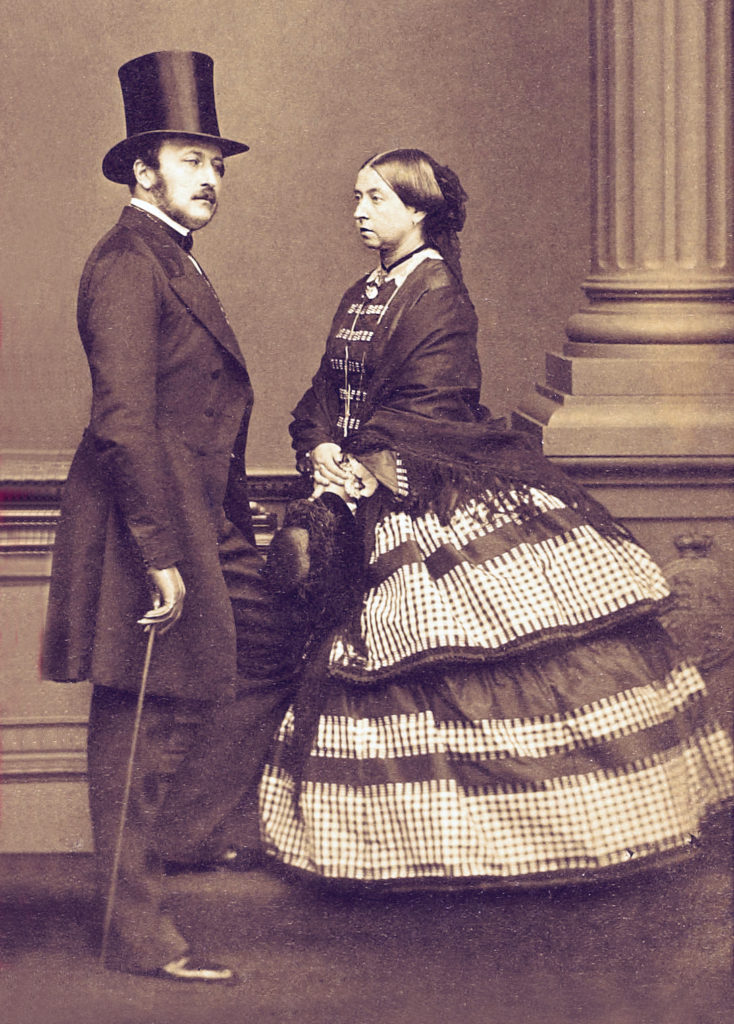
The bronze medal is described as being in the shape of a Maltese cross (actually, a cross pattée is used), slightly more than one-and-a-half inches high and the same in width. The front bears an imprint of St. Edward’s crown with a British lion above and the slogan “For Valour” below. The slogan originally considered for the medal was “For The Brave,” but that was changed to “For Valour” on Victoria’s suggestion, noting that the original slogan seemed to imply that not all men were brave in battle. The cross hangs from a gold bar on the obverse. On the reverse is inscribed the recipient’s name, rank, number, and unit. The date on which the act for which the award is being presented is engraved on the back of the bronze cross. The cross in turn hangs from the gold bar and a crimson ribbon about one-and-a-half inches wide.
Originally a Victoria Cross with a crimson ribbon (officially prescribed as “red” but which has always been “crimson” or “wine-red” in color) was awarded to army honorees while one with a dark blue ribbon was given to navy honorees until all subsequent Victoria Cross medals were issued in crimson after 1918. Since 1917 a miniature of the cross can be seen in the center of the bar.
Made from a cannon?
In the few cases (three to date) in which two VCs have been awarded to a single individual, a second miniature cross is placed next to the first. The three double-winners are: Surgeon Capt. Arthur Martin-Leake, who won one VC in the Boer War and one in World War I; Capt. Noel Godfrey Chavasse, who won two in World War I; and New Zealander Capt. Charles Hazlitt Upham, who won two in World War II.
To date, the Victoria Cross has been awarded 1,358 times to 1,355 individuals with almost half, 628, awarded for actions taken during World War I and 181 in World War II. Since the end of World War II, 15 VCs have been awarded: four in the Korean War; one for Malaya; four (to Australians) in the Vietnam War; two in the Falklands War; one in the Iraq War; and three in the War in Afghanistan. All 15 medals have been awarded to military personnel. No British civilian has received the award since 1879.
Women became eligible for the Victoria Cross in 1921. However, no woman has yet been awarded one, although Elizabeth Webber Harris, a colonel’s wife serving with her husband in India, was awarded an “honorary” VC for heroic efforts treating victims of an 1869 cholera epidemic. By comparison, the United States’ highest military honor, the Medal of Honor, first awarded during the American Civil War, has been presented 3,511 times, including 19 medals to individuals who have received two. It was also awarded to one woman, Dr. Mary Edwards Walker, a Civil War physician.
It was claimed that Victoria Crosses have all been made from the metal of Russian cannon captured at the siege of Sevastopol in the Crimean War, but historian Glanfield, after studying a metallurgical examination of VCs in the custody of the Australian War Memorial, authoritatively established that Victoria Crosses—at least those made since December 1914—come from the metal of two Chinese cannons. Enough metal from that source is still available to make 80 to 85 more Victoria Crosses. The metal is kept in a vault controlled by the Royal Logistics Corps at Donnington, Shropshire and can be removed from the vault only in the presence of an officer and armed guards.
First Presented by Queen Victoria
Normally, a recommendation for the awarding of a Victoria Cross is issued by an officer at the regimental level with a minimum of three witnesses swearing to the accuracy of the claims of heroism for which it is intended. The recommendation must then work its way up the chain of command until it reaches, first, the Secretary of State for Defense and then the reigning monarch for approval.
In 1867, the award also was made available to colonial troops. After World War II, most Commonwealth countries created their own system of military awards, which often include a Victoria Cross medal created by that country and no longer directly take part in Great Britain’s medals system. However the UK government can recommend Commonwealth citizens for UK honors, and the British monarch is also the sovereign of certain Commonwealth honors systems, such as those of Australia, Canada and New Zealand.
Initial official policy was that posthumous VC awards should not be made. Between 1897 and 1901, as British soldiers fought in colonial wars and in China’s Boxer Rebellion, the London Gazette listed soldiers who would have been awarded VCs had they survived. In 1902, six of those soldiers mentioned in the Gazette were “unofficially” granted VCs and later awarded medals after the policy prohibiting posthumous VCs was officially reversed in 1920.
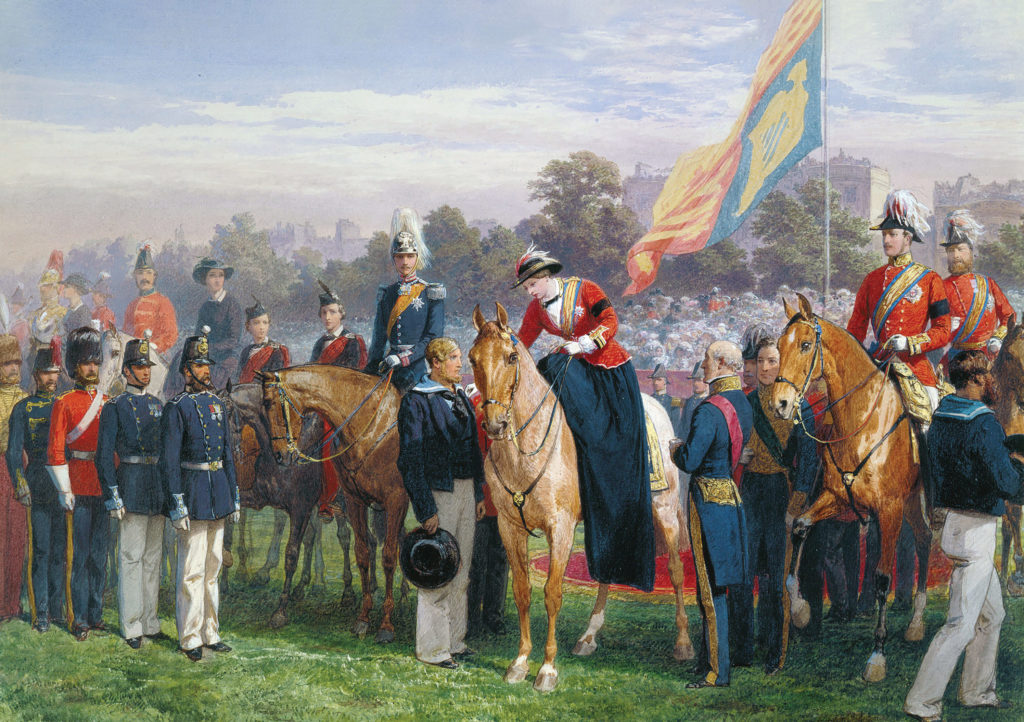
The Victoria Cross warrant does not specify who should present the actual medals to the honorees. Queen Victoria liked to present them herself and presented the first 62 awarded. That presentation took place on a hot June 26, 1857 in London’s Hyde Park before massed British troops, including dragoons, hussars, a troop of Royal Horse Artillery with two field batteries, Royal Engineers, three battalions of Foot Guards, and others. A large crowd gathered and cheered loudly as the troops formed and the 62 men about to be awarded the VC marched and stood in a single line facing the troops and a table holding the medals.
Lucas was fourth in the line that had been formed by rank. Just before 10 a.m., the field batteries sounded, and the Queen approached on horseback accompanied by Albert, who that very day had received the title of Queen’s Consort. Also present on horseback were the Prince of Wales, who would become Edward VII, and his brother Alfred. Sir John Smyth has called the scene “poignant and impressive.”
How the VC Changed views About Soldiers
Among the honorees were 26 men from the lower ranks: 16 army privates; four gunners; one sapper; two seaman; and three boatswains. Besides Lucas, two other men from the Hecla also received VCs that day, Lt. John Bythesea and Stoker William Johnstone. The first man to receive his medal was the redoubtable Charles David Lucas.
The medals appear to have been awarded chronologically by the date of the action for which they were being awarded. Lord Panmure, Secretary of State for War, called the name of each man and handed the proper individually-inscribed medal to the Queen. The man then stepped forward, bowed to the Queen, and Victoria leaned from her saddle and pinned the medal to the man’s chest.
After the ceremony Lucas remained in the Royal Navy, was promoted in 1862 and for a time commanded the experimental armored gunboat HMS Vixen. He was promoted to captain in 1867, retired in October 1873, and was named a rear admiral after his retirement. Five years later, in 1878, he was summoned to the deathbed of his former captain, Adm. Sir William Hutcheson Hall, who asked Lucas to take care of his wife Hilaire after he was gone and to marry his only daughter, Frances Russell Hall. Always loyal, Lucas complied, marrying Frances in 1879. The couple went on to have three daughters before Lucas died at Great Culverden, Kent on Aug. 7, 1914. He is buried at St. Lawrence’s Church, Mereworth, Maidstone, Kent.
Since its first en masse award in 1857, the Victoria Cross has become not only Great Britain’s highest military honor, but one of the world’s most prestigious valor medals. The late author Sir John Smyth, who won a Victoria Cross in France during World War I, has called it “the most famous award for gallantry in the world” while historian Glanfield has called it “Britain’s supreme decoration.”
The award also changed perceptions about ordinary soldiers. “Before the war,” Prof. Orlando Figes wrote, “the respectable middle and upper classes had viewed the rank and file of the British Army as little more than a dissolute rabble—heavy-drinking and ill-disciplined, brutal and profane.” But no longer. The Victoria Cross “marked a new reverence for war and warriors.”

